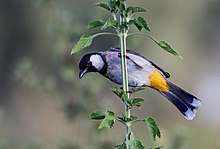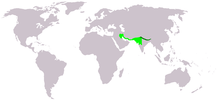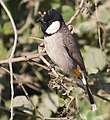White-eared bulbul
| White-eared bulbul | |
|---|---|
 | |
| White-eared bulbul in Vasai, Maharashtra, India | |
| Scientific classification | |
| Kingdom: | Animalia |
| Phylum: | Chordata |
| Class: | Aves |
| Order: | Passeriformes |
| Family: | Pycnonotidae |
| Genus: | Pycnonotus |
| Species: | P. leucotis |
| Binomial name | |
| Pycnonotus leucotis (Gould, 1836) | |
 | |
| Distribution of P. leucotis (light green) and P. leucogenys (dark green) in the South Asian region | |
| Synonyms | |
| |
The white-eared bulbul (Pycnonotus leucotis), or white-cheeked bulbul, is a member of the bulbul family. It is found in south-western Asia (IRAN) from India to the Arabian peninsula.
Taxonomy and systematics
The white-eared bulbul was originally described in the genus Ixos. The white-eared bulbul is considered to belong to a superspecies along with the Himalayan bulbul, white-spectacled bulbul, African red-eyed bulbul, Cape bulbul, and the common bulbul.[2] Formerly, some authorities considered the white-eared bulbul to be a subspecies of the Himalayan Bulbul. The alternate name, white-cheeked bulbul, is also used by the Himalayan bulbul. In Iran it is sometimes referred to as "the bulbul of Tehran".[3]
Subspecies
Two subspecies are recognized:[4]
Description
This species is very similar in appearance to the Himalayan white-cheeked bulbul but smaller and uncrested, and with a larger white cheek patch. It has a pale bare eye-ring. The vent is orange yellow. Sexes are alike.
It is found in scrub forest and gardenland. Also found in flocks or pairs in the mangroves, gorging on the fruits of the Meswak bush. Usually seen in pairs or small groups. It feeds on fruits and insects, and breeds in March–June.
Gallery

.jpg)
.jpg) P. l. mesopotamia in Musandam Peninsula, Oman
P. l. mesopotamia in Musandam Peninsula, Oman- White-eared bulbul at Birdworld, Farnham
References
- ↑ BirdLife International (2016). "Pycnonotus leucotis". The IUCN Red List of Threatened Species. IUCN. 2016: e.T22712687A94342904. doi:10.2305/IUCN.UK.2016-3.RLTS.T22712687A94342904.en. Retrieved 15 January 2018.
- ↑ "Himalayan Bulbul (Pycnonotus leucogenys)". www.hbw.com. Retrieved 2017-03-23.
- ↑ http://fhnews.ir/fa/news/79802/The Bulbul of Tehran
- ↑ "Bulbuls « IOC World Bird List". www.worldbirdnames.org. Retrieved 2017-03-23.
- Pocket Guide to the Birds of the Indian Subcontinent (1999) and multiple reprints. Richard Grimmett, Carol Inskipp and Tim Inskipp, Oxford University Press, New Delhi
External links
| Wikimedia Commons has media related to Pycnonotus leucotis. |
